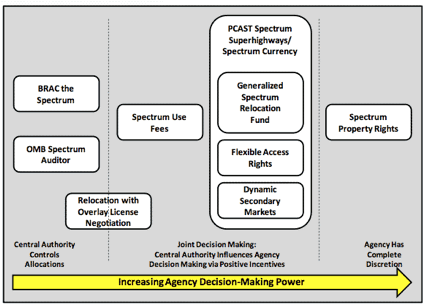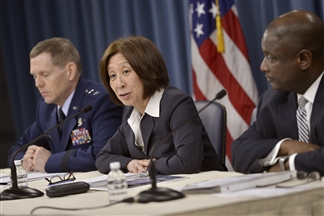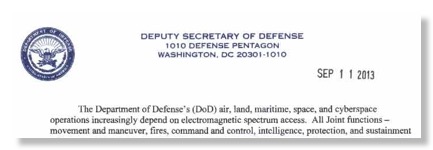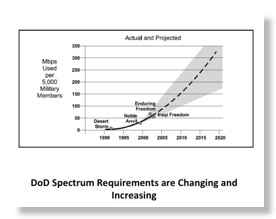NTIA Improves Federal Spectrum Use WebsiteBut Real Problems Remain
Check out NTIA’s new & improved spectrum compendium detailing federal spectrum uses. Now with better search tools! http://t.co/5JZ7mfXlwq
— NTIA (@NTIAgov) May 7, 2015With the above tweet NTIA announced a major improvement to its publicly available information on federal spectrum use. The information below from the new page describes the type of information now available:

For the bands between 225 MHz and 5 GHz the new site gives details on US allocations, number of NTIA assignments for federal users, and future federal plans for the bands.
The table at left shows the type of data available and its limitations. For the first time we can remember NTIA has revealed large amounts of data on federal assignments (equivalent to licenses in FCC jargon). As the table notes:
“The number of actual systems, or number of equipments, may exceed and sometimes far exceed, the number of frequency assignments in a band. Also, a frequency assignment may represent, a local, state, regional, or nationwide authorization. Therefore, care must be taken in evaluating bands strictly on the basis of assignment counts or percentages of assignments.”
The reason for this is that NTIA’s record keeping has evolved over decades and in ancient history agencies could get nationwide assignments for an unlimited amount of transmitters in an unlimited number of locations. I recall that the spectrum enforcement site of FCC, the part now slated for a huge staffing cut, has 3 UHF land mobile channels on such a nationwide basis even though I doubt it ever had 300 mobile radios. But in the early days assignments were “free” and even now agencies pay NTIA only for the number of assignments, not the number of transmitters or locations. Clearly many IRAC members do not want this to change so NTIA probably doesn’t have better information on the number of federal transmitters and it many cases does not know where that are.
It is also unclear if these numbers include classified assignments.
What is missing? Those of us who are fans of Benn Kobb’s now out of print, but available on Kindle, Wireless Spectrum Finder, will miss common names for many federal systems, although the section that includes GPS calls it “GPS”.
More importantly, there is no indication on where each assignment is used or how heavily it is used. Much federal spectrum use is outside of urbanized area where there is the greatest demand for new spectrum. Thus having some knowledge, even any knowledge of which bands are used in urban areas and which are more often used in rural areas would be very helpful.
We have criticized NTIA in the past for not publishing spectrum occupancy data in certain bands and we have also printed an apology and correction when NTIA pointed out we missed some data they had published. But the new pages do not contain any links to previously published NTIA data on band occupancy or data from any other sources like the IIT Spectrum Observatory. While it is unlikely NTIA will cite such private sector data, it is puzzling why published NTIA data is not cross-referenced.
Is “sharing is the new normal” more information on intensity of use and general geographic nature of use would be very helpful in improving national spectrum management policy.
While spectrum below 5 GHz is of prime interest in the cellular industry’s endless appetite for more spectrum, spectrum above 95 GHz that presently lacks any FCC rules for commercial use is all shared with federal users and there is no real public data on what is going on there. In order to facilitate commercial evolution in that spectrum we urge NTIA to make some information available on present and planned spectrum uses for federal users and sharing potentials.
But we congratulate NTIA on a positive step forward with the new information.
Cell Phone Spying & FCC
Today’s Washington Post had an article entitled “Tech firm tries to pull back curtain on surveillance efforts in Washington”. The above video was part of the article on their web page.
The article discussed the apparent proliferation of “IMSI catchers” in the DC area. It explains
“Known as IMSI catchers, for the unique identifying phone code called an IMSI, the surveillance devices trick mobile phones into thinking they have logged onto legitimate cell networks, such as Verizon or AT&T, when in fact the signals have been hijacked.
For years, researchers have warned of the growing prevalence of the equipment, and Turner said the spygear is rife throughout the Washington area.
In August the Post reported that FCC has been asked by Rep. Grayson to look into allegations that FCC had long known about cellular network vulnerabilities to such privacy invasions.
YOur blogger was particularly troubled by the statement in today’s Post article that said: “It does not have authority, FCC officials say, over government use of this surveillance technology.” Presumably “government” in this context meant “federal government” because clearly FCC has authority over state and local governments with repeat to use of radio transmitters. But even in the case of the the federal government, FCC is not without power. While a straightforward reading of the Communications Act of 1934 gives parallel and independent authority for regulating transmitters to FCC under § 301 and the President for federal users under § 305, since the 1940s the agency administering the President’s § 305 authority, now NTIA, and FCC have had a written understanding that they would seek consent of the other for transmitters in bands where that might impact the transmitters authorized by the other party. The current agreement is here.
In practice, this agreement is rigorously adhered to. So it is inconceivable that NTIA would authorize FBI or some other “3 letter agency” to use a “IMSI catcher” that included a transmitter without informing FCC and seeking “coordination”. This does not involve a vote by the commissioners and is a fairly routine action normally handled within OET. Did the “8th Floor” know about such a request from NTIA? I have no idea. But I am certain that no agency would have taken such action without seeking NTIA authorization and that NTIA would not have given such authorization without seeking some level of approval from FCC.
This the unnamed FCC ”officials” quoted above either didn’t know what they was talking about or were intentionally misleading.
UPDATE
DC News FOX 5 DC WTTG
DC’s Fox station on “fake towers” in DC: Tech company finds mysterious fake cell towers in DC area
Correction: NTIA/ITS Measurements 225-400 MHz
For example here are several recent NTIA occupancy measurement reports that include 225-400 MHz data:
- NTIA Technical Report TR-14-502: Broadband Spectrum Survey in the Chicago, Illinois, Area - Data taken in September 2012 and published in April 2014.
- NTIA Technical Report TR-13-496: Broadband Spectrum Survey in the Denver Area - Data taken in June 2011 and published in August 2013
- NTIA Technical Report TR-14-498: Broadband Spectrum Survey in the San Diego, California, Area - Data taken in May and June 2012 and published in November 2013
In addition, while many previous NTIA/ITS reports did not include 225-400 MHz, these 2 did:
- NTIA Technical Report TR-95-321: Broadband spectrum survey at Denver, Colorado - Data taken in September and October of 1993 and published in September 1995
- NTIA Technical Report TR-97-334: Broadband spectrum survey at San Diego, California - Data taken in September and October of 1993 and published in December 1996.
We apologize to NTIA and our readers for presenting information that was not correct and not noticing the change in late 2013 in this area. We are correcting all the past posts that discuss this issue to include a link to this correction.
Spectrum Job Open at NTIA

Job Title: Telecommunications Policy Specialist (DEU) (Spectrum Clearing)
Department: Department Of Commerce
Agency: National Telecommunications and Information Administration
Job Announcement Number: NTIA-FRNA-2014-0069
| SALARY RANGE: | $89,924.00 to $138,136.00 / Per Year | ||
| OPEN PERIOD: | Wednesday, April 16, 2014 to Wednesday, April 23, 2014 | ||
| SERIES & GRADE: | GS-0301-13/14 | ||
| POSITION INFORMATION: | Career or Career Conditional - Full Time/Permanent | ||
| PROMOTION POTENTIAL: 14 | DUTY LOCATIONS: | 1 vacancy in the following location: Washington DC, DC | |
| WHO MAY APPLY: | All qualified U.S. citizens | ||
| SECURITY CLEARANCE: | Secret | ||
| SUPERVISORY STATUS: | No | ||
This position is currently located in Washington D.C. but will relocate to Reston, VA in the near future. This position is also being announced concurrently under Merit Assignment Procedures (MAP) vacancy number: NTIA-FRNA-2014-0068. Applicants who wish to be considered under MAP must apply to both vacancies separately. This position is located in the U.S. Department of Commerce (DOC), National Telecommunications and Information Administration (NTIA), First Responder Network Authority (FirstNet). FirstNet is a new independent authority within NTIA that will be responsible to design, build, deploy, operate, and maintain a nationwide, interoperable public safety broadband network pursuant to Title VI of the Middle Class Tax Relief and Job Creation Act of 2012, Pub. L. No. 112-96 (the Act). FirstNet holds a single, public safety wireless license of 22 megahertz (MHz) of spectrum between the frequencies of 758-769 MHz and 788-799 MHz.
The specialist in this position will report to the Director of Regulatory Strategy of FirstNet and will be responsible for performing complex assignments concerning the extensive range of spectrum issues for FirstNet. The position will perform work with a high degree of transparency and include the FirstNet leadership in the work being done.
For details surf over to https://www.usajobs.gov/GetJob/ViewDetails/367394100
UPDATE
Here are some jobs now open in spectrum policy at FCC also:
(This is actually an unusually large number of such openings at the same time.)
Electronics Engineer
This position is located in the Office of Engineering and Technology, Laboratory Division in Columbia, MD. THIS ANNOUNCEMENT HAS BEEN AMENDED TO EXTEND THE CLOSING DATE TO 4/28/14 FROM 4/21/14.
| Salary: | $106,263.00 - $157,100.00 / Per Year |
| Series & Grade: | GS-0855-14/15 |
| Location(s): | Columbia, Maryland |
| Open Period: | 4/7/2014 to 4/28/2014 |
| Announcement Number: | DEU-OET-2014-002 |
Electronics Engineer
This position is located in the International Bureau, Strategic Analysis and Negotiations Division, Cross Border Negotiations and Treaty Compliance Branch. Relocation expenses will not be paid.
| Salary: | $63,091.00 - $116,901.00 / Per Year |
| Series & Grade: | GS-0855-11/13 |
| Location(s): | District of Columbia, District of Columbia |
| Open Period: | 4/16/2014 to 5/15/2014 |
| Announcement Number: | DEU-IB-2014-001 |
This position is located in the Office of Engineering and Technology, Policy and Rules Division.
| Salary: | $75,621.00 - $116,901.00 / Per Year |
| Series & Grade: | GS-0855-12/13 |
| Location(s): | District of Columbia, District of Columbia |
| Open Period: | 4/8/2014 to 4/22/2014 |
| Announcement Number: | DEU-OET-2014-003 |
2 Unsual Places Ask for Comments on US Spectrum Policy
The OSTP request was published in February in the Federal Register and announced on the OSTP website on February 14, 2014 in a blog post by Tom Power, U.S. Deputy Chief Technology Officer for Telecommunications. Also released at the same time was a report by the IDA Science and Technology Policy Institute (a “think tank dedicated to OSTP operated by your blogger’s former employer - many years ago - IDA) entitled “A Review of Approaches to Sharing or Relinquishing Agency-Assigned Spectrum”. The request comes from the White House “Spectrum Policy Team”, a sort of virtual recreation of the spectrum functions of the old White House Office of Telecommunications Policy was recommended in the 7/12 PCAST spectrum policy. The team was created by the Presidential Memorandum of 6/14/13 and consists of
The 6/14/13 memorandum told the team to “monitor and support advances in spectrum sharing policies and technologies” and told NTIA to “consult” with the team on various details of implementing the memorandum. Readers may recall that at the time of the memorandum, this blog speculated that the team might be the “adult supervision” that NTIA and IRAC have long needed (in our view) to bring federal agency spectrum policy more inline with national goals. (Up until 1978 spectrum policy oversight was based in the White House and the White House staff served as a check on whether IRAC actions really served national goals. With the creation of NTIA in 1978, the head of NTIA - an assistant secretary of Commerce - lacked the “clout” and direct access to key White House staff to reliably keep agencies in line if they became parochial.)“The Chief Technology Officer and the Director of the National Economic Council, or their designees, shall co-chair a Spectrum Policy Team that shall include representatives from the Office of Management and Budget (OMB), the National Security Staff, and the Council of Economic Advisers. The Spectrum Policy Team shall work with NTIA to implement this memorandum. The Spectrum Policy Team may invite the FCC to provide advice and assistance.”
The IDA report addresses “nine major approaches to providing incentives to Federal agencies to share or relinquish assigned spectrum”. Six of these are market-based approaches, e.g. spectrum fees or agency property rights, while the last three are directed reallocation and sharing approaches. The following chart summarizes the options:

The comment date on this request has now passed and the the comments are now available here. (Due to a clerical error, when this is being posted CTIA’s comments are missing from the consolidated .pdf file this links to. OSTP is aware and working to correct this.) Basically all the comments favor the economic approaches except for Lockheed Martin, a card carrying member of the military industrial complex, who says user fees are bad idea and prefer a “Spectrum Innovation Fund for federal users and says that “incentives to share spectrum must promote the employment of innovative technologies by federal agencies”.

The House Energy & Commerce Committee, presumably the Republican majority given our dysfunctional Congress, released on 4/1/14 a white paper on spectrum policy. The Committee seeks comments saying,“(w)hile the questions posed in this white paper address specific spectrum issues, the committee encourages interested parties to comment on any aspect of spectrum policy. Responses should be submitted to CommActUpdate@mail.house.gov by April 25, 2014.” They are also using the Twitter hashtag #CommActUpdate to stimulate discussion. The white paper deals with 10 basic areas, most with 1-2 questions. Some overlap with the OSTP document, for example “What should be done to encourage efficient use of spectrum by government users?”
The IDA report and OSTP makes interesting reading and are strongly recommended. The House committee questions also are thought provoking. We hope readers will comment on them.
DoD Electromagnetic Spectrum Strategy Release

Teri Takai, center, the Defense Department's chief information officer, Air Force Maj. Gen. Robert E. Wheeler, left, the department's deputy chief information officer, and Frederick J. Moorefield Jr., right, the department's director of spectrum policy and programs, brief reporters on the department's release of its electromagnetic spectrum strategy. DOD photo by Glenn Fawcett .
On Thursday February 20, 2014 “The Department of Defense announced … the release of its Electromagnetic Spectrum Strategy (EMS) to increase available spectrum in order to meet growing demand from the commercial wireless industry while maintaining critical military capabilities.” CTIA responded almost immediately with this statement from Steve Largent:
“We agree with the DoD's conclusion that its systems must become more spectrally efficient, flexible and adaptable. In fact, these are good goals for all federal users, and CTIA looks forward to engaging with the DoD, NTIA and the whole federal user community to see how the wireless industry can help them achieve their mission objectives while ensuring that commercial users have access to the spectrum our members need to meet consumer demand and drive economic growth and innovation.”
The first thing we noticed, sort of the “elephant in the room”, was that the report that was released was dated “SEP 11 2013”:

and was actually titled “Electromagnetic Spectrum Strategy 2013 - A Call to Action”. Why this 2013 report was released more than 3 months after it was signed and dated in an unclassified form is a mystery not mentioned in any trade press coverage. Our best guess was that there are a behind the scenes disagreement somewhere within in the Executive Branch or between FCC and NTIA. CTIA’s prompt response indicates that they were not waiting for the report to appear on the DoD website.
The following diagram from the report shows that DoD has a better handle on quantifying its needs than CTIA does with its famous “flag chart”: DoD quantifies its mobile communications needs in terms of “Mbps per 5000 Military Members” and shows how this has increase dramatically and will continue to do so. The cellular industry, by contrast, denominates its requirements solely in terms of MHz, independent of technical developments and the gains due to infrastructure growth/cell splitting. Now presumably the industry projection included expected gains from technical efficiency improvements and infrastructure growth, but these are never itemized nor are they updated. For example, due to the availability of new technology in the past 3 years, has the spectrum requirements in the “flag chart” increased or decreased? The real requirement for both DoD and the cellular industry is really denominated in data rate as DoD has done in this report. Kudos to DoD.
Getting to the actual report, it fully supports the reallocations ordered by President Obama in June 2010 to get 500 MHz of new spectrum to cellular carriers from existing federal and non-federal spectrum. No great surprise.
A key section says:
DoD systems must become more spectrally efficient, flexible, and adaptable, and DoD spectrum operations must become more agile in their ability to access spectrum in order to increase the options available to mission planners. (Spectrum efficiency is the use of the minimum amount of EMS resources necessary to ensure maximum operational effectiveness in fully accomplishing the required mission while taking all practicable steps to minimize impacts to other systems in the EME.Spectrum flexibility and adaptability is the capability of a spectrum-dependent system (SDS) to exploit various opportunities to access spectrum – e.g., multi-band operation, increasing the ability to share spectrum with other systems (domestic or foreign, federal, or non-federal), becoming more tolerant of interference. Agile spectrum operations will enable DoD systems to utilize their flexibility and adaptability to achieve mission success in rapidly changing EMEs.)
In the past, spectrum was a “free good” (except for minor NTIA regulatory fees) for DoD and other federal users and there was no incentive to be efficient as long as enough spectrum was obtainable. Top level attention to spectrum efficiency is thus a good move in the right direction and hopefully NTIA will extend this to other agencies. But the focus in this discussion is making military systems more agile so they can access more bands as they operate around the world.
What is missing is what NTIA Chief Larry Stickling said a few months ago, “sharing is the new normal”. While DoD is implementing White House orders to make spectrum available for the politically (and economically) powerful cellular industry, will DoD be more receptive to sharing proposals in other bands and be less likely to automatically stonewall? We have repeatedly pointed out that 225-400 MHz military use generally is very different geographically than civil use (San Diego being a notable exception) and that with new technology it could be made available to civil users on an “interruptible spectrum” basis, not unlike what is being considered for the 3550-3650 MHz band. Will DoD be receptive to such creative sharing proposals? We hope so but the new policy statement is silent on the issue.
We hope DoD and NTIA will clarify the issue of what is meant by “sharing is the new normal” and specifically whether this is a one way street with respect to military spectrum use in US territory.

Will spectrum sharing in US territory be a one way street for DoD?
UPDATE
See http://www.marcus-spectrum.com/Blog/files/SpecMeasCorr414.html
Sharing Federal Spectrum - New Report

Of particular interest to your blogger was Section VII. Facilitating Sharing: Incentivizing Federal Users. Federal users currently pay a small fee that supports the costs of the NTIA spectrum office. But the fee structure is not well known and is about $150/NTIA assignment. An assignment might be a 25 kHz channel in one city, a communications satellite, or a nationwide system. The fee is the same as NTIA has never been able to work out with the IRAC a better system.
Here is the description of Section VII from the executive summary of the report:
It is widely accepted that until Federal users internalize the costs associated with their spectrum use, they have little incentive to use spectrum more efficiently or support proposals to share their spectrum. If federal users paid for spectrums use, they would internalize the cost associated with holding spectrum assignments that prevent other productive uses of the frequencies.
Recognizing the costs of spectrum through a federal fee would incentivize federal users to adjust their usage to reduce costs. While there are limitations to a fee-based approach, it would require government users to incur some cost for spectrumusage. By imposing a spectrum based fee, the cost of spectrum based services for federal users will reflect the use of this scarce resource. The question is: what should the fee be tied to?
Consistent with the principle that government spectrum users should consider the forgone economic value of spectrum deployed for their services, we suggest that a federal user fee should be based on the commercial value of spectrum. By tying the fee for federal spectrum to spectrum’s commercial price, federal users would be incurring the foregone economic value or opportunity cost of the spectrum in deploying these federal services. A fee based on the commercial value of spectrum would require that federal users at least acknowledge this opportunity cost of the spectrum use and publicly argue that the value of their use of the spectrum exceeds this opportunity cost.





![Validate my RSS feed [Valid RSS]](valid-rss-rogers.png)

